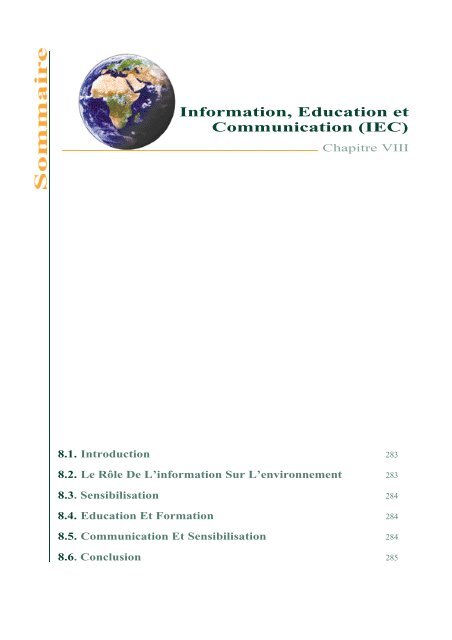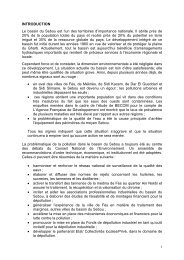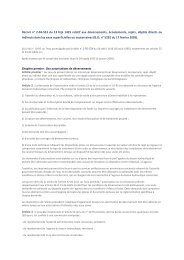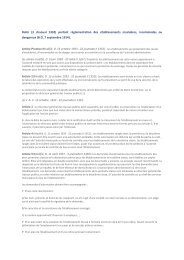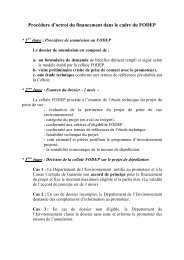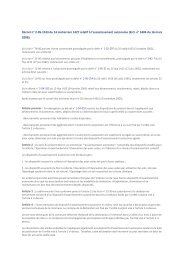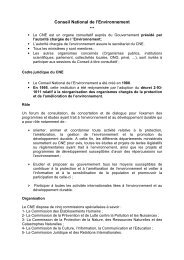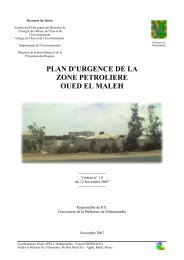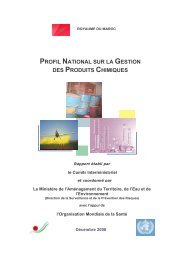Information, Education et Communication (IEC) - Département de l ...
Information, Education et Communication (IEC) - Département de l ...
Information, Education et Communication (IEC) - Département de l ...
- No tags were found...
You also want an ePaper? Increase the reach of your titles
YUMPU automatically turns print PDFs into web optimized ePapers that Google loves.
<strong>Information</strong>, <strong>Education</strong> <strong>et</strong><strong>Communication</strong> (<strong>IEC</strong>)Chapitre VIII8.1. Introduction 2838.2. Le Rôle De L’information Sur L’environnement 2838.3. Sensibilisation 2848.4. <strong>Education</strong> Et Formation 2848.5. <strong>Communication</strong> Et Sensibilisation 2848.6. Conclusion 285
<strong>Information</strong>, <strong>Education</strong> <strong>et</strong><strong>Communication</strong> (<strong>IEC</strong>)Chapitre VIII8.1. INTRODUCTIONLe Maroc s’est engagé dans un processus <strong>de</strong>développement relativement accéléré. Il est à la veilled’une large opération <strong>de</strong> privatisation. Ce qui peutengendrer une pression croissante sur ses ressourcesnaturelles, si <strong>de</strong>s mesures <strong>de</strong> précautions ne sont pasprises. Nous constatons déjà une compétition pour lesressources en sols <strong>et</strong> les ressources en eau entrel’agriculture, l’industrie, le tourisme, les transports <strong>et</strong>l’habitat.“ L’information constitue l’un <strong>de</strong>s plus importantsfacteurs <strong>de</strong> développement <strong>de</strong>s sociétés”, a préciséSM LE ROI MOHAMED VI, alors Prince Héritier, àla journée nationale <strong>de</strong> l’information tenue à Rabat19 novembre 1998.Les impératifs du développement risquent donc, siles mesures nécessaires ne sont pas prises, <strong>de</strong>conduire à une dégradation du patrimoine national <strong>et</strong>à une augmentation <strong>de</strong> la pollution. Une connaissanceapprofondie <strong>de</strong>s problèmes <strong>de</strong> l’environnement,venant d’une analyse <strong>de</strong>s intéractions entreles activités du développement <strong>et</strong> leurs impacts surl’environnement, est indispensable à toute politiquecohérente <strong>de</strong> développement durable.Les déci<strong>de</strong>urs <strong>et</strong> le public ont besoin <strong>de</strong>l’information environnementale. L’ I n f o r m a t i o n ,l’<strong>Education</strong> <strong>et</strong> la <strong>Communication</strong> (<strong>IEC</strong>) sont aussifondamentales pour toute politique <strong>de</strong> protection <strong>de</strong>l’environnement.Toute gestion rationnelle <strong>de</strong> l’environnementpasse obligatoirement par une prise <strong>de</strong> connaissance<strong>de</strong> l’ampleur <strong>de</strong>s problèmes. La promotion <strong>de</strong>comportements respectueux <strong>de</strong> l’environnement <strong>et</strong>l’implication <strong>de</strong>s populations sont nécessaires à lamise en œuvre d’une politique responsable enmatière <strong>de</strong> protection <strong>de</strong> l’environnement.L’objectif du programme <strong>de</strong> l’<strong>IEC</strong> est d<strong>et</strong>ransm<strong>et</strong>tre par les différents moyens <strong>de</strong> communication<strong>et</strong> selon le modèle "Pression - Etat - Réponse "à tous les intervenants (individus ou collectivités,industriels <strong>et</strong> déci<strong>de</strong>urs à l’échelle centrale ou locale)une connaissance du concept <strong>de</strong> l’environnement, <strong>de</strong>séquilibres <strong>de</strong> l’écosystème <strong>et</strong> <strong>de</strong> la position <strong>de</strong>l’homme dans c<strong>et</strong> écosystème.8.2. LE ROLE DEL’INFORMATION SURL’ENVIRONNEMENTL’information sur l’environnement peut seprésenter sous formes <strong>de</strong> donnée,s <strong>de</strong> statistiques oud ’ indicateurs plus globaux. Ces <strong>de</strong>rniers perm<strong>et</strong>tentl’évaluation <strong>de</strong>s conditions environnementales <strong>et</strong> <strong>de</strong>stendances, comme ils peuvent servir à la détermination<strong>de</strong> politique ou à sa rectification. L’information perm<strong>et</strong>donc aux déci<strong>de</strong>urs d’analyser les relations <strong>de</strong> cause àe ff<strong>et</strong>, d’élaborer <strong>de</strong>s stratégies en vue <strong>de</strong> gérer lesressources naturelles, <strong>de</strong> prévenir <strong>et</strong> combattre lapollution <strong>et</strong> d’évaluer les progrès accomplis.L’information doit répondre aux besoins <strong>de</strong>sdéci<strong>de</strong>urs, <strong>de</strong> l’ensemble <strong>de</strong>s utilisateurs potentiels,<strong>et</strong> du grand public. Une fois l’information obtenue¸ ilest nécessaire <strong>de</strong> la diffuser <strong>et</strong> l’interpréter sousdifférentes formes. A c<strong>et</strong>te fin le Département <strong>de</strong>l’Environnement s’est doté d’un ObservatoireNational <strong>de</strong> l’Environnement (ONEM), qui estl’organe producteur <strong>et</strong> diffuseur <strong>de</strong> l’informationenvironnementale.L’ONEM a donc un rôle <strong>de</strong> collecte, d’évaluation<strong>et</strong> <strong>de</strong> diffusion <strong>de</strong> l’information environnementale envue d’une ai<strong>de</strong> à la prise <strong>de</strong> décision.Il doit contribuer à m<strong>et</strong>tre à la disposition, notamment<strong>de</strong>s déci<strong>de</strong>urs, une information essentiellementinscrite dans la ligne du Développement Durable,pouvant être évaluée selon :• les niveaux <strong>de</strong> répercussions en termes d’impactssanitaires ;• la productivité <strong>de</strong>s ressources en relation avec lacapacité <strong>de</strong>s milieux à soutenir l’eff<strong>et</strong> <strong>de</strong> l’activitéhumaine ;Rapport sur l’Etat <strong>de</strong> l’Environnement du Maroc283
<strong>Information</strong>, <strong>Education</strong> <strong>et</strong><strong>Communication</strong> (<strong>IEC</strong>)Chapitre VIII• l’évaluation <strong>de</strong>s coûts directs <strong>et</strong> indirectss’appuyant sur la connaissance <strong>de</strong>s causes <strong>de</strong> ladégradation <strong>de</strong> l’environnement <strong>et</strong> <strong>de</strong>s solutionsefficaces sur le plan environnemental <strong>et</strong> financier.A ce titre, il est important <strong>de</strong> signaler, outre leprésent Rapport sur l’Etat <strong>de</strong> l’Environnement, quepour la première fois au niveau national, une rubriqueenvironnement a été introduite au sein <strong>de</strong> l’annuairestatistique national (version 2000), grâce à une collaborationentre l’Observatoire National <strong>de</strong> l’Environnement<strong>et</strong> la Direction <strong>de</strong> la Statistique qui apermis <strong>de</strong> m<strong>et</strong>tre en place un comité réunissantplusieurs départements en vue <strong>de</strong> collaborer dans laréalisation <strong>de</strong> ce chapitre. La prochaine version <strong>de</strong> c<strong>et</strong>annuaire (version 2001), englobera également, selonla même approche, une version actualisée du chapitreenvironnement.Aussi, pouvons-nous également citer une actiond’importance en terme <strong>de</strong> gestion <strong>et</strong> <strong>de</strong> diffusion <strong>de</strong>l’information environnementale, à savoir l’utilisation<strong>de</strong>s Nouvelles Technologies <strong>de</strong> l’<strong>Information</strong> <strong>et</strong> <strong>de</strong> la<strong>Communication</strong> (NTI) par la participation <strong>de</strong>l’Observatoire National <strong>de</strong> l’Environnement à lacréation d’un site WEB pour le Département <strong>de</strong>l’Environnement, en tant que support dynamique <strong>et</strong>évolutif <strong>de</strong> la gestion <strong>de</strong> l’information environnementale(www.minenv.gov.ma).8.3. SENSIBILISATIONAu sein du Département <strong>de</strong> l’Environnement, ilest important également <strong>de</strong> signaler le rôle <strong>de</strong> laDirection chargée <strong>de</strong> la <strong>Communication</strong> <strong>et</strong> <strong>de</strong> laFormation Continue qui joue un rôle catalyseur <strong>et</strong>complémentaire en terme d’information, maiségalement d’éducation <strong>et</strong> <strong>de</strong> sensibilisation.Ainsi, plusieurs programmes médiatiques ont étéentrepris <strong>et</strong> plusieurs campagnes <strong>de</strong> sensibilisation,concernant les secteurs jugés prioritaires <strong>de</strong> l’eau, <strong>de</strong>l’air, <strong>et</strong> <strong>de</strong> la gestion <strong>de</strong>s déch<strong>et</strong>s ont été réalisés.Pendant la pério<strong>de</strong> estivale <strong>de</strong> l’année 1999, unecampagne <strong>de</strong> gran<strong>de</strong> envergure a été entreprise par leDépartement <strong>de</strong> l’Environnement, sous la prési<strong>de</strong>nceeffective <strong>de</strong> S.A.R la Princesse Lalla Hasna, sur l<strong>et</strong>hème "Plages propres". Une caravane a été organiséepour sensibiliser les estivants à la propr<strong>et</strong>é <strong>de</strong>splages. C<strong>et</strong>te campagne a été reproduite durant les<strong>de</strong>ux précé<strong>de</strong>ntes années <strong>et</strong> a permis <strong>de</strong> consoli<strong>de</strong>r lesefforts entrepris <strong>et</strong> <strong>de</strong> développer une démarchenovatrice basée sur le partenariat Public/Privé <strong>et</strong>l’implication du citoyen dans la gestion <strong>de</strong> l’environnement; démarche qui se veut évolutive pours’élargir progressivement aux autres thèmes <strong>de</strong> laprotection <strong>de</strong> l’environnement national. La créationrécente <strong>de</strong> la Fondation Mohamed VI pourl’environnement, présidée par SAR la PrincesseLALLA HASNA, donne la mesure à l’importanceaccordée à ce secteur par la plus Haute autorité dupays.8.4. EDUCATION ETFORMATIONL’éducation <strong>et</strong> la formation constituent leséléments essentiels d’une prise <strong>de</strong> conscienceenvironnementale.L’éducation tend à inculquer aux apprenants lesconnaissances, les valeurs, les attitu<strong>de</strong>s à adopter visà vis <strong>de</strong> l’environnement. A ce titre, les actionssuivantes ont été menées par la Direction <strong>de</strong> la<strong>Communication</strong> au sein du Département <strong>de</strong>l’Environnement :• Elaboration <strong>et</strong> mise en œuvre du proj<strong>et</strong>-éducation Vaxé sur l’éducation <strong>et</strong> la formation en matièred’environnement dans les cursus scolaires,• L’élaboration <strong>et</strong> la production <strong>de</strong> supportsdidactiques <strong>et</strong> pédagogiques d’éducation environnementale,• L’élaboration <strong>de</strong> programmes <strong>de</strong> formationthématiques (déch<strong>et</strong>s, littoral, <strong>et</strong>c…)8.5. COMMUNICATION ETSENSIBILISATIONLe Département <strong>de</strong> l’Environnement a élaboré en1995, une stratégie <strong>de</strong> communication.Ainsi, toute action <strong>de</strong> sensibilisation auxproblèmes <strong>de</strong> l’environnement est d’abord, un moyenindispensable <strong>de</strong> correction <strong>de</strong>s attitu<strong>de</strong>s <strong>et</strong> <strong>de</strong>scomportements, <strong>et</strong> ensuite, un instrument d’anima-Rapport sur l’Etat <strong>de</strong> l’Environnement du Maroc284
<strong>Information</strong>, <strong>Education</strong> <strong>et</strong><strong>Communication</strong> (<strong>IEC</strong>)Chapitre VIIItion, <strong>de</strong> prévision <strong>et</strong> <strong>de</strong> vigilance qui accompagne lesopérations <strong>de</strong> gestion <strong>de</strong>s ressources <strong>et</strong> <strong>de</strong> restauration<strong>de</strong> l’espace.Afin <strong>de</strong> conjuguer <strong>et</strong> rationaliser les efforts, lanouvelle politique du gouvernement, a mis en place<strong>de</strong>s mécanismes <strong>de</strong> partenariat <strong>et</strong> <strong>de</strong> coopération avectous les intervenants dans le domaine <strong>de</strong> lacommunication environnementale. Les partenariatssont développés entre les départements ministériels,les médias, les organismes publics, semi-publics, sansoublier les représentants <strong>de</strong> la société civile (ONG).Les Organisations Non Gouvernementales (ONG)sont considérées comme <strong>de</strong>s vecteurs efficaces <strong>de</strong>communication entre la population, les communautés<strong>et</strong>/ou le gouvernement. Les ONG travaillant pourl’environnement sont assez nombreuses. Nous avonsdénombrer un nombre avoisinant les quatre cents auniveau national. Leur importance <strong>et</strong> champs d’actionsont diversifiés à la mesure <strong>de</strong>s préoccupationsenvironnementales.8.6. CONCLUSIONSelon le modèle Pression Etat Réponse adopté,nous pouvons considéré l’<strong>Information</strong>, <strong>Education</strong> <strong>et</strong>la <strong>Communication</strong> (<strong>IEC</strong>), d’une part en tant quemoyen d’accompagnement <strong>de</strong> la politique <strong>de</strong> l’état enmatière <strong>de</strong> protection <strong>de</strong> l’environnement mais aussien tant que Réponse selon le modèle précité. ■Rapport sur l’Etat <strong>de</strong> l’Environnement du Maroc285


